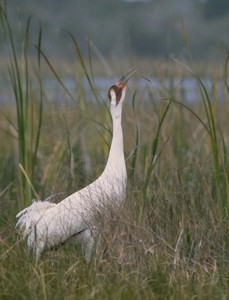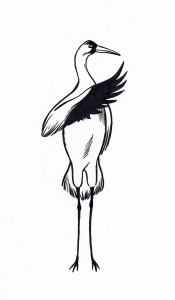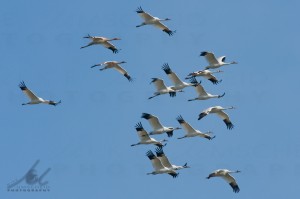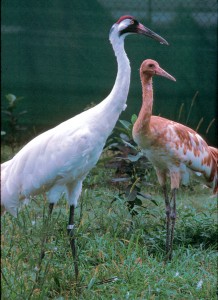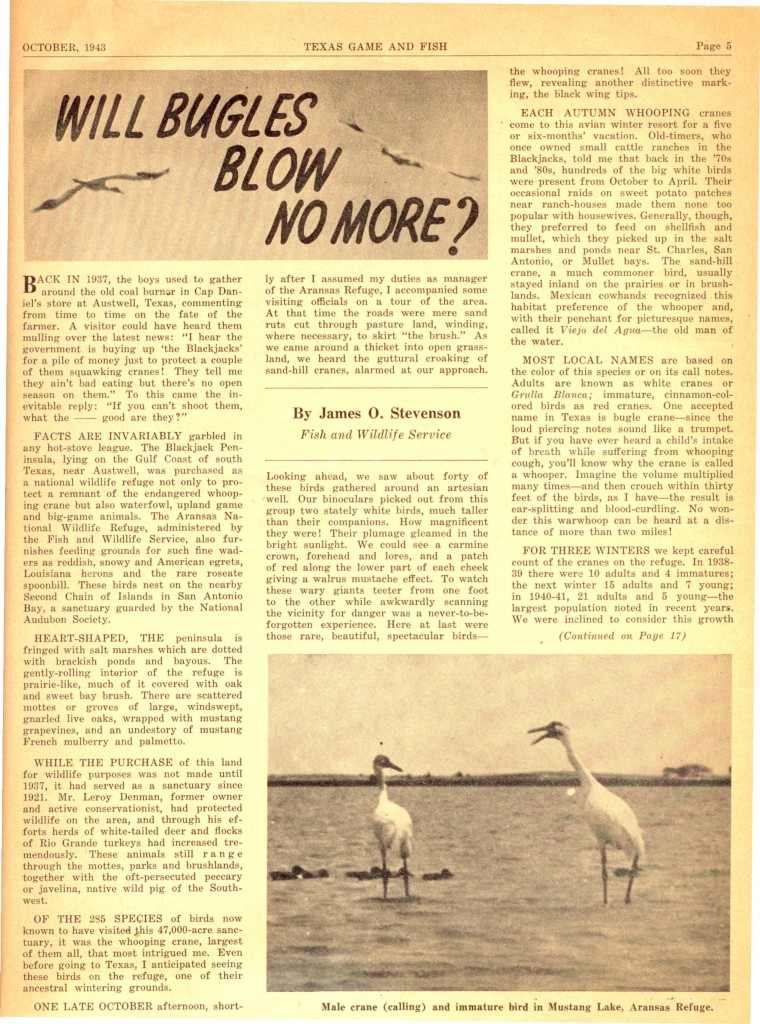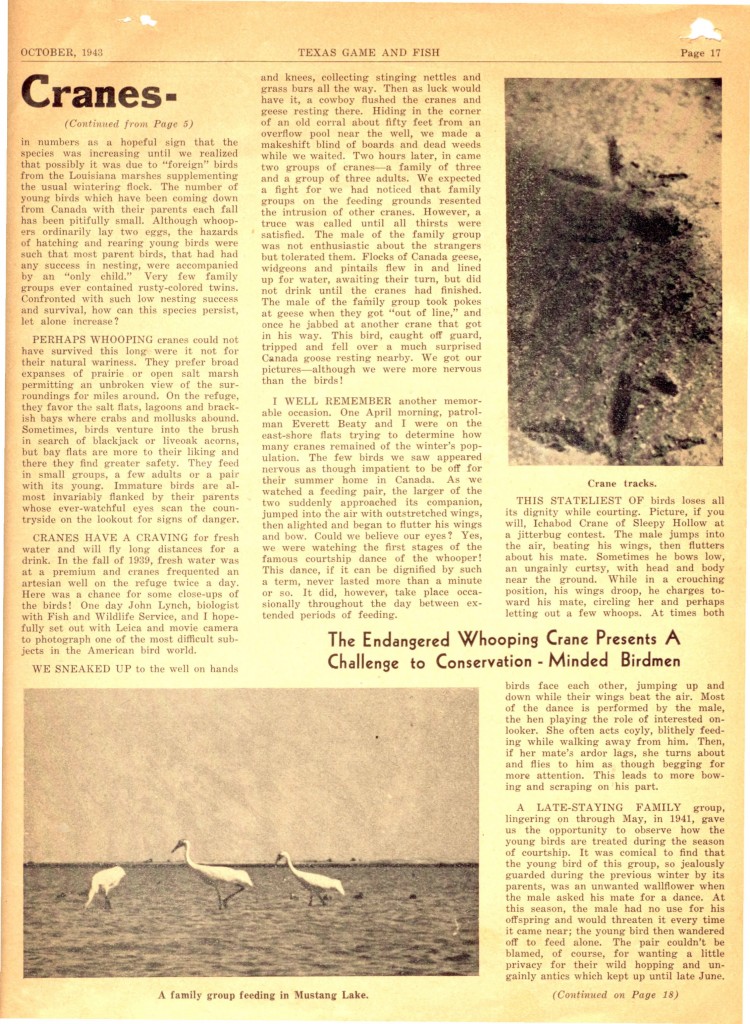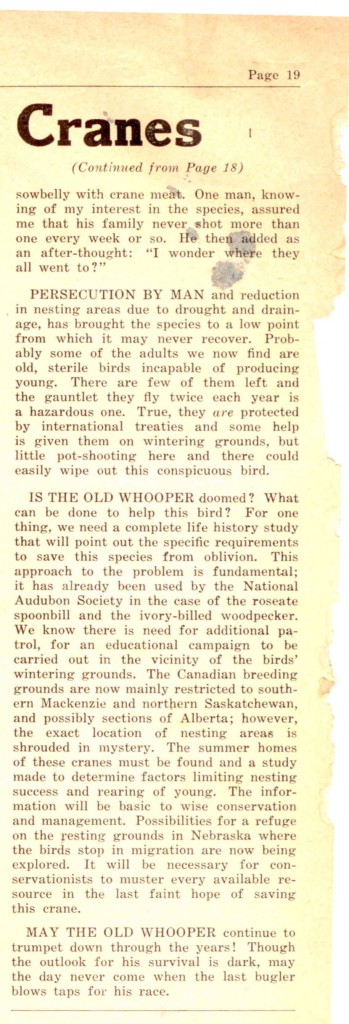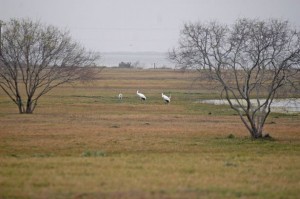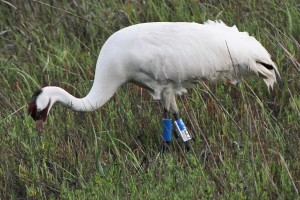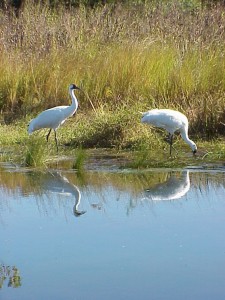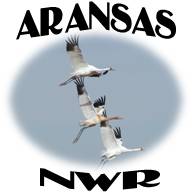Archive for the ‘Aransas NWR Updates’ Category
Big Win For Whooping Cranes
March 12, 2013Editor’s Note:After three years of waiting, the court has made its decision on the case, “The Aransas
Project vs. Bryan Shaw, et al.” The result is a tremendous victory for endangered whooping cranes and their habitats. In summary, too much fresh water was being removed from upstream sources and whooping crane habitats downstream, on and around the Aranasas National Wildlife Refuge, was being robbed of an equitable share of fresh water. This has had, and is continuing to have, a severe adverse effect on whooping cranes.After reading the “Introduction” and the “Memorandum Opinion and Verdict of the Court”, we decided to post it here verbatim because it is written in such a clear and concice manner. And you will have the facts as the court had written them. For those wanting to read the entire court decision, click on: http://thearansasproject.org/wp-content/uploads/2013/03/TAP-Opinion.pdf
UNITED STATES DISTRICT COURT, SOUTHERN DISTRICT OF TEXAS,CORPUS CHRISTI DIVISIONTHE ARANSAS PROJECT, Plaintiff, VS. BRYAN SHAW, et al., Defendants.
INTRODUCTION.
In the annals of conservation, the return of the Whooping Crane from the brink of extinction is one of the most fabled stories. In the 1940’s, less than fifteen of these remarkable birds – the tallest in North America and the rarest species of crane in the world – remained. With the creation of wildlife refuges and other conservation efforts, the population of the birds has slowly risen to, including both those in captivity and those not in captivity, to around 500 birds. At issue here is the threat of extinction to the non-captivity population of around 300. However, the “whoopers” are still at risk, as development and environmental issues continue to threaten their habitat.
This case concerns the world’s only self-sustaining, wild Whooping Crane population, known as the “AWB” flock, and its winter home in South Texas at the Aransas National Wildlife Refuge (the “Refuge”), and surrounding estuarine areas that comprise the AWB cranes’ critical winter habitat. The AWB cranes normally begin to arrive at their winter habitat in late October, and depart in early April of the following year.
The Aransas Refuge is located midway along the Texas Gulf coast, about 140 miles southof Houston and 50 miles north of Corpus Christi. The cranes’ wintering grounds are comprisedof approximately 9,000 hectares of salt flats on the Refuge itself and also on adjacent islands,including the Blackjack Peninsula, San Jose Island, and Matagorda Island.
The area is bordered on the east by the Gulf of Mexico, receiving daily impulses of salt water with the changing of the tides. The Refuge receives freshwater inflows from primarily two river sources, the San Antonio and the Guadalupe, each located to the north and slightly west of the area.
The San Antonio river flows into the Guadalupe river system, and the Guadalupe river flows directly into the Refuge, emptying into the San Antonio bay. The area where the freshwater enters the Refuge is referred to correctly as the “Guadalupe estuary,” but it is known also as the “San Antonio bay.” The San Antonio and the Guadalupe river systems emerge from underground springs near San Antonio and run 250 miles southeast where they join together just before entering the San Antonio bay and flow into the AWB flock’s winter habitat, that extends slightly north of the Refuge.
These freshwater inflows come from a combination of spring flows and rainfall. Whooping Cranes face extinction. Indeed today, it is estimated that only 500 Whooping Cranes exist worldwide. In 1967, the United States listed the Whooping Crane as threatened with extinction, 32 Fed. Reg. 4001 (Mar. 11, 1967), and in 1970, they were listed as endangered 35 Fed. Reg. 16047 (Oct. 13, 1970). In 1973, both of these classifications were “grandfathered” into the Endangered Species Act. 16 U.S.C. § 1531, et seq., 87 Stat. 884.
Beginning in 1950, the United States Fish & Wildlife Service (USFWS) employed aerial surveys to provide an annual census of how many AWB cranes arrived at the Refuge in the fall, and how many departed in the spring. Mr. Tom Stehn, a USFWS biologist, worked at the Refuge for over 29 years, and personally developed and implemented a method to count the individual birds of the AWB flock utilizing the cranes’ well-documented behaviors of site fidelity, site tenacity, and crane territoriality.0 Because specific birds returned to their specific locations, Mr. Stehn was able to map their territories and to confirm their presence or absence with weekly aerial surveys. Based on his intimate knowledge of the AWB crane and his mapping of their territories, Mr. Stehn concluded that, at the start of the 2008 winter season, the AWB flock had grown to its peak number of 270 birds, plus or minus 2 to 3 percent.
During the 2008-2009 winter, there was a severe drought. As the winter progressed, the AWB cranes began to demonstrate unusual behavior. For example, parents would deny their juveniles food, and the birds began venturing out of their specific territories in search of food and fresh water. When the cranes first arrive at the Refuge, it is normal for the parents to feed the juvenile. The juveniles’ beaks are soft and tender, and it is necessary for the parent to break the shell and feed the crab to the begging juvenile. As the winter progresses, the parent pulls the crab from the water, kills it, and leaves it for the juvenile. During the 2008-2009 winter, Dr. Chavez Ramirez observed a parent aggressively pushing his juvenile away from a crab that had been caught. He had never seen a parent deny food to a begging juvenile. Such behavior indicates that the parent was under food stress. The birds’ behavior was so alarming that Mr. Stehn contacted Dr. Chavez-Ramirez, a biologist with two decades of field research on the AWB cranes and a member of the International Whooping Crane Recovery Team, and asked him to visit the Refuge and observe the cranes. Dr. Chavez-Ramirez was equally troubled and concerned with his observations of the cranes’ behavior. Both he and Mr. Stehn observed that the lack of freshwater inflows had increased salinities across the Refuge. These hyper-saline conditions, verified by field measurements, led to a decrease in blue crabs and wolfberries, the staple diet of the AWB flock. This food shortage led to bird emaciation, stress behavior, and an over-all decline in bird health. That is, without proper freshwater inflows, the AWB’s critical habitat had been thrown out of balance, with ramifications up and down the food chain. That winter, at least 23 AWB cranes, or 8.5 % of the AWB flock, died at the Refuge. Another 34 birds that left Texas in spring, failed to return in fall.
After news of the high crane mortality in the 2008-2009 winter became known, certain environmentalists, local coastal business owners, bird enthusiasts, and others formed “The Aransas Project,” (“TAP”), a Texas nonprofit corporation. The TAP members have a direct interest in the AWB Whooping Cranes and the ecological health of the San Antonio, Carlos, Mesquite, and Aransas bays that connect to the Refuge.
The State of Texas owns its surface water, and this includes the water in the Guadalupe and the San Antonio River systems. Under Texas law, freshwater capture and use is regulated by the Texas Commission on Environmental Quality (TCEQ), a State agency. Through its permit process and regulatory powers, the TCEQ can affect the availability of freshwater to users along the river system.
Prior to filing this lawsuit, TAP petitioned the TCEQ for a water permit to require a certain amount of freshwater to remain instream in the Guadalupe and San Antonio river systems to ensure that sufficient amounts of freshwater reached the Refuge and surrounding areas adjacent to the San Antonio bay that comprise the critical habitat of the AWB cranes. TAP’s permit request was denied, and on December 7, 2009, TAP gave notice of its intent to sue.
On March 10, 2010, TAP filed this lawsuit alleging that the TCEQ defendants had violated Section 9 of the Endangered Species Act (ESA), 16 U.S. C. § 1531 et seq., by failing to properly manage freshwater inflows into the San Antonio and Guadalupe bays during the 2008-2009 winter, causing an unlawful “take” of AWB cranes. (D.E. 1). TAP maintains that the TCEQ defendants’ water management practices during 2008-2009, combined with the severe drought, drastically modified the AWB cranes’ critical habitat making it hyper-saline. In turn, the hyper-saline conditions caused a reduction in the availability of wolfberries and blue crabs, the cranes’ primary food resources, as well as in fresh drinking water. The lack of food and freshwater caused the cranes to become emaciated and to engage in stress behavior. Emaciation led to increased illness and disease susceptibility, and the cranes’ unusual stress behaviors including leaving the safety of their site territories, contributed to increased predation. In total, the adverse modification of the cranes’ critical habitat effectively caused the death of at least 23 Whooping Cranes that winter season, constituting a “take” under the ESA.
MEMORANDUM OPINION AND VERDICT OF THE COURT
Thus, it is therefore DECLARED that:
(1) The TCEQ, its Chairman, and its Executive Director have violated section 9 of the ESA, and continue to do so through their water management practices which include the decision to not monitor D&L users or to exercise emergency powers available to protect the endangered whooping cranes; and
(2) Texas water diversion regulations promulgated by the TCEQ, its Chairman, its Executive Director, and the Texas legislature are preempted by federal law when they purport to authorize water diversions that result in a taking of whooping cranes.
Therefore, it is ORDERED that:
(1) The TCEQ, its Chairman, and its Executive Director are enjoined from approving or granting new water permits affecting the Guadalupe or San Antonio Rivers until the State of Texas provides reasonable assurances to the Court that such permits will not take Whooping Cranes in violation of the ESA.
(2) Within thirty (30) days of the date of entry of this Order, the TCEQ, its Chairman, and its Executive Director shall seek an Incidental Take Permit that will lead to development of a Habitat Conservation Plan. See 16 U.S.C. § 1539(a); 50 C.F.R. § 17.22(b) (listing requirements for an Incidental Take Permit)
The Court will retain jurisdiction over this action during the formulation of the HCP process. The Court finds that Plaintiff TAP is the prevailing party in this matter, and is entitled to an award of its reasonable attorney’s fees and costs, as well as expert witness fees, incurred in this action. See 16 U.S.C. § 1540(g)(4).
SIGNED and ORDERED this 11th day of March, 2013. Janis Graham Jack Senior United States District Judge
The Whooping Crane Conservation Association appreciates the decision made by U.S. District Judge Janis Graham Jack and the work of James Blackburn, everyone on The Aransas Project team, Tom Stehn and other private citizens who made our voices heard! This is a tremendous decision in favor of endangered whooping cranes and other wildlife along the Texas coast that need and deserve their share of fresh water.
Winging it 2,500 Miles to Rear Their Families
March 9, 2013by Chester McConnell, Whooping Crane Conservation Association
Some whooping cranes are heading north. They are departing from Aransas Refuge on the Texas coast. They’re on their way to Canada’s Wood Buffalo nesting grounds 2,500 miles away. Only a small number from the Aransas/Wood Buffalo flock have departed from Aransas but others will soon follow. According to Dr. Wade Harrell, U.S. Whooping Crane Recovery Coordinator: “It appears that some whooping cranes have started to migrate back north, which is several weeks earlier than normal. Perhaps this is not surprising given the unusually warm and dry winter that the southern plains have experienced.”
March brings restlessness to the wintering cranes as days get longer. Cranes of the Aransas/Wood Buffalo flock could encounter dangerous cold and stormy weather if they move north too rapidly. But, whoopers heading to Canada must race for their nesting grounds where summers are short. Adult pairs have to build a nest, lay two eggs and incubate the eggs for 30 days when the chicks hatch. Then they must feed the chicks large amounts of food to get the youngsters ready for the long migration back to Texas. So, whoopers have much to do in a short time on the nesting grounds. Hopefully the northern habitats will be thawed and ready for nesting when they arrive. Most of the Wood Buffalo nesting area is still currently frozen. But whooping cranes are wise and the migration to Canada normally requires 40 to 60 days.
So most likely icy conditions will change before most of the cranes arrive there.Yet, whoopers are definitely in their migration mode. Citizen whooper watchers have reported birds in northern Texas, Oklahoma, Kansas and Nebraska. Eight whoopers were reported as far north as North Platte, Nebraska. Migration records kept by the Whooping Crane Conservation Association indicate about two dozen birds along the migration route. Some of these observations have been verified by U.S. Fish and Wildlife Service refuge managers.
Hopefully all the whooping cranes currently on the way to Canada and those waiting on Aransas Refuge, Texas will have a safe 2,500 mile migration. We know that, sadly, two members of this flock will not be with them. They were shot and killed during the past year, one by a poacher (South Dakota) and the other by a hunter (Texas). Both of the men who killed the whoopers have been prosecuted and received large fines and other punishment. The Whooping Crane Conservation Association urges state and federal wildlife agencies and birding organizations along the migration route to increase their efforts to educate hunters and other citizens about the compelling need to help protect endangered whooping cranes.
Interestingly, Dr. Harrell’s “Wintering Whooping Crane Update” report (3/7/2013) described the movements of one whooper family that has GPS transmitters attached to them: “Update February 24: The marked family group (two adults and one juvenile) from Granger Lake left arriving in North Texas that evening. They stayed through Feb. 28 and then moved to SW Oklahoma where they remained through March 2. They then moved on to Quivira National Wildlife Refuge in South Central KS, a traditional migration stopover site for whooping cranes, where they currently remain.”
More about whooping crane migration can be learned by reading The Whooping Crane Tracking Partnership’s recently issued biannual report. The following is a summary of the data captured from the 2012 breeding season through fall migration (approximately May through November). Background information about the Partnership can be found on the following link: https://whoopingcrane.com/tracking-whooping-cranes-telemetry-update/
Excerpts from the report: “During the 2012-2013 season, information was gathered about location from 36 transmitters during the breeding season and data from 30 transmitters during fall migration. Prior to migration, six transmitters stopped providing data. With the help of the technology, the mortalities of two juveniles and two subadults were confirmed on the breeding grounds of Wood Buffalo National Park. The two other transmitters were confirmed to have broken antenna. The tracking technology also revealed that three cranes spent the summer months in south-central Saskatechewan and 29 marked birds completed the fall migration.”
“The birds began their fall migration from Canada on September 7, 2012, and data indicates that all of the birds arrived on the Texas coast by November 27, 2012. It took the cranes an average of 46 days to make the migration with the migration time ranging from 21 to 67 days. The data shows whooping cranes used 261 different locations where they stopped and stayed for more than one night. Stopover locations occurred in every state and province in the Great Plains. Cranes spent the most time at staging sites in Saskatchewan and the Dakotas. The general migration corridor used was similar to past migrations and there were no mortalities detected during the migration.”
“The GPS tracking devices attached to the whooping cranes are programmed to record four locations daily and provide both daytime and nighttime locations. Transmitters upload data approximately every 2.5 days allowing for monitoring survival. The technology allows biologists to learn which habitats are being used and where the birds stop during their migration – important information when prioritizing management decisions.”
The Whooping Crane Conservation Association supports the Whooping Crane Tracking Partnership’s in hopes that the information they collect will help in the improved management of the whoopers.
Dallas Man Convicted and Fined for Killing Whooping Crane
March 7, 2013by Chester McConnell, WCCA
Worthey D. Wiles, 42, of Dallas, has entered a plea of guilty and was sentenced for killing a whooping crane .Wiles killed the whooping crane on January 12, 2013. The announcement was made by United States Attorney Kenneth Magidson today along with Nick Chavez, special agent in charge of U.S. Fish and Wildlife Service (FWS).
Wiles was a guest hunter at the St. Charles Bay Hunting Club in Rockport which is located inside the designated critical habitat for whooping cranes. While hunting in the marsh adjacent to San Jose Island, Wiles shot and killed a juvenile whooping crane. After contacting Texas Parks and Wildlife (TPW), Wiles told state game wardens he thought the whooping crane was a Sandhill crane. Wardens then contacted FWS who located the bird and verified it was a whooping crane.
Even though Wiles believed he was shooting a Sandhill crane, hunting for them is illegal near San Jose Island where the bird was killed and throughout the whooper’s traditional wintering habitat centered on the Aransas National Wildlife Refuge north of Rockport.
“The whooping crane is one of the most beautiful and highly valued species of America’s wildlife heritage,” said Chavez. FWS is committed to protecting this extraordinary bird so that future generations of Americans are able to marvel at its grace and beauty.”
Wiles, a Dallas duck hunter shot and killed one of the juvenile cranes that had hatched and been reared by its wild parents during the summer of 2012 on Wood Buffalo, Canada nesting grounds. The young whooping crane was one of only 34 produced in Canada in 2012 and was killed during its first visit to the Texas coast. It had successfully completed its first 2,400 mile migration from Canada to Texas. Young whoopers have a potential life span of 40 or more years if they remain healthy. The Whooping Crane Conservation Association asserts that even the loss of one crane from the approximate 300 wild whoopers in the world is a serious tragedy.
Whooping cranes are one of the rarest birds in the world with a total population of approximately 437 cranes in the wild and 599 overall. The whooping crane population that winters in Texas is the only self-sustaining wild population of whooping cranes in the world. This case is only the fifth known shooting death of a whooping crane since 1968. Killing one of the approximate 300 wild whooping cranes that migrate from Canada to Texas is a federal violation of the Endangered Species Act. Punishment spans a broad range of fines, restitution fees and prison terms. Under the federal Endangered Species Act it is a crime to harm, harass or kill a federally-protected species. Violators face fines of up to $250,000 and up to one year in jail.
Today, when Wiles appeared before United States Magistrate Judge B. Janice Ellington, he entered a plea of guilty to one count of violating the Migratory Bird Treaty Act, which provides protection for Migratory Birds. As a result, he was ordered to pay a $5,000 fine and make a $10,000 community service payment to the non-profit organization Friends of Aransas and Matagorda Island National Wildlife Refuges. He will also serve a one-year-term of probation for his conviction. The Whooping Crane Conservation Association stated it is pleased that a $10,000 community service payment is going to Friends of Aransas and Matagorda Island National Wildlife Refuges. The organization performs valuable voluntary services for the refuge.
In a recently settled case, a South Dakota man who shot and killed a whooping crane was ordered to pay $85,000 in restitution and serve two years’ probation. He was also required to surrender his firearms used in the offense and will lose his fishing, hunting and trapping privileges anywhere in the United States for two years and pay a $25 assessment to the Victim Assistance Fund. A Whooping Crane Conservation Association spokesman said restitution should be a minimum of $150,000 based on the amount of time, effort, research, land costs, law enforcement and other expense that goes into nurturing and protecting these iconic birds. Likewise, the Association believes jail time should be imposed on violators to let it be known that such crimes are serious.
The Aransas County death is the fifth known Texas case involving the shooting of a whooping crane since 1968, though another crane death in Calhoun County remains under investigation. Previous Texas cases from 1989 and 1991 ended in fines totaling $21,000 and $23,100 respectively.
Will Bugles Blow No More?
March 4, 2013Editor’s note: Pam Bates, historian with the Whooping Crane Conservation Association, enjoys searching old files for interesting information about whooping cranes. We have posted several of her finds on this web page for your information and reading pleasure. Pam recently located an article titled “Will Bugles Blow No More?” written by James Osborne Stevenson in the Texas Game and Fish newsletter.
James Osborne Stevenson became the first refuge manager of the Aransas National Wildlife Refuge in Texas under the Bureau of Biological Survey. There he spent much of his time observing, studying, and photographing whooping cranes. He took the first ever color films of their courtship dances, and published a number of scientific and public interest articles on these cranes. In 1943, he published an article called Will Bugles Blow No More? about their endangerment. Jim died of a stroke on October 14, 1991.
If you have problems reading the article, double-click on the articles to enlarge the print.
Whooper Updates from The Aransas Project
February 16, 2013by Ron Outen, Regional Director, The Aransas Project, Feb. 16, 2013
USFWS Releases 2012-2013 Whooping Crane Estimate
USFWS has posted their 2012-2013 Winter Whooping Crane Survey. USFWS estimates the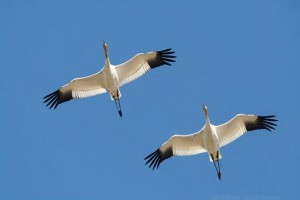 flock size to be 257 birds using their new distance sampling method. This estimate does not reflect an actual count of the flock size, but instead offers a 95% probability that the actual flock size is somewhere between 178-362 birds.
flock size to be 257 birds using their new distance sampling method. This estimate does not reflect an actual count of the flock size, but instead offers a 95% probability that the actual flock size is somewhere between 178-362 birds.
TAP issued this statement by Regional Director Ron Outen in response to the release of the estimate: “With the new flock-estimation methodology, there will be no more actual counts of individual birds. By their own analysis, USFWS offers a 95% probability that the actual flock size is somewhere between 178-362 birds. TAP remains concerned that the level of uncertainty with this sampling method is unacceptably high for a population this size. Additionally, the method fails to locate territories or detect mortality—all valid concerns raised by former Whooping Crane Coordinator Tom Stehn.
More fundamentally, the community—both locally and internationally—has come to expect an accurate count of the cranes and flock size year to year on the wintering grounds. We urge that USFWS reinstitute an actual census of the cranes in addition to this new methodology until it can be further peer reviewed and refined to ensure accuracy.”
Shootings of Whooping Cranes Highlight Other Risks to Flock
Two recent articles highlight the variety of threats faced by whooping cranes, both as they migrate to and from the wintering grounds in and around Aransas National Wildlife Refuge and once they arrive.
The Whooping Crane Conservation Association recently posted a release from the U.S. Attorney’s Office, District of South Dakota, entitled “South Dakota Man Guilty of Whooping Crane Murder.” The release detailed the sentencing of a South Dakota man who pled guilty to the April 2012 killing of an adult male whooping crane. The release notes that:
“The whooping crane killed in this case was one of about 300 wild whooping cranes that migrate from wintering grounds along the gulf coast of Texas to the Wood Buffalo State Park located in Alberta and the Northwestern Territories of Canada. This population of whooping cranes is the only self-sustaining population in the world.”
The plea resulted in the man being sentence to $85,000 in restitution, 2 years of probation, a $25 assessment to the Victim Assistance Fund, forfeiture of the rifle used, and a 2-year ban from hunting, fishing or trapping.
Closer to home,it was recently reported that a duck hunter turned himself in to a game warden in Aransas County in connection with the accidental shooting of a juvenile whooping crane in January of this year on St. Joseph’s Island. According to the report, the hunter believe that the juvenile was a sandhill crane, and turned himself in when he discovered that it was a juvenile whooping crane.
Former Whooping Crane Coordinator Tom Stehn notes that the Aransas National Wildlife Refuge is in the process of opening the Matagorda Island marshes to waterfowl hunting, and suggests that perhaps hunters should be required to take an online identification course to better protect the whooping cranes.
Operation Migration On Estimating Whooper Numbers
February 2, 2013Operation Migration’s “In The Field” web page explains, “Debate continues in the Whooping crane world about the methods US Fish and Wildlife Service is now using to count Whooping cranes at the Aransas National Wildlife Refuge.”
“For almost 30 years, retired Whooping Crane Coordinator, Tom Stehn made a direct count of each bird while flying transacts over the refuge. The accuracy of that method was questioned because birds may move between the aircraft passes and been counted more than once.”
“The new system employed since Stehn’s retirement is called ‘distance sampling’. It consists of making multiple parallel survey flights over a large area and applying a formula to the number of cranes spotted to come up with a population estimate.”…
“The concern is that distance sampling is generally used to estimate the size of large populations and there are fewer than 300 Whooping cranes at Aransas. Many feel that a direct count could provide a more accurate number.”
To read the complete article, click on: http://operationmigration.org/InTheField/2013/02/01/controversy-heats-up/
USFWS Whooping Crane Meeting Video
November 7, 2012by Ron Outen, Regional Director, The Aransas Project
On the evening of October 24, TAP attended a second public presentation by USFWS on the new distance sampling methodology being used at Aransas National Wildlife Refuge. Refuge Biologist Brad Strobel again presented his Powerpoint presentation for a small audience. TAP captured the presentation on video presentation on video, and has also posted the PowerPoint presentation to the TAP website Note that this PowerPoint is from the Oct. 4, 2012 presentation, but the content is essentially the same one used at the Oct. 24, 2012 presentation (minor changes included new slides with staff bios, current conditions).
At the meeting, Strobel reported that USFWS is currently planning to conduct additional flights this season beyond the three flights conducted last season, as well as potentially making additional adjustments in the protocol such as flying narrower transects than the current transect of 1,000 meters.
Refuge staff reported on the current conditions on the winter range, which has been posted to the Aransas National Wildlife Refuge website in the first Whooping Crane Update of the season.
TAP Files Response to Defendants’ Motion to Reopen Case
Shortly following the issuance of the “Aransas-Wood Buffalo Whooping Crane Abundance Survey (2011-2012)” by USFWS on October 3, the defendants in TAP’s lawsuit under the federal Endangered Species Act filed a motion seeking to reopen the record in the case (9 months after the trial of the case) to introduce the Abundance Survey into the record.
Last week, TAP filed its Plaintiff’s Response to Defendants’ Motion to Reopen Case opposing the motion of the defendants’ to reopen the case. TAP has posted its response to the TAP website for the benefit of TAP’s members and members of the public seeking to remain informed about the case.
Nesting Success Good For Whooping Cranes In 2012
October 8, 2012by Chester McConnell, Whooping Crane Conservation Association
Whooping crane nesting success on Wood Buffalo National Park, Canada during 2012 was considered good but slightly down from previous years. This is good news after the poor winter season on Aransas National Wildlife Refuge in Texas.
Sixty six (66) whooping crane nests were discovered in May by the CanadianWildlife Service. Three months later in August, an additional three (3) family groups were identified indicating that there were at least sixty-nine (69) nesting attempts during the2012 nesting season. In early August, just prior to fledging, thirty-four (34) young were observed on the breeding grounds. Two (2) sets of twins were observed. Ten of the young whooping cranes were marked with leg bands and satellite transmitters.
Martha Tacha, U.S. Fish and Wildlife Service reports that: “The whooping cranes began moving down into staging areas in Saskatchewan last month; a week ago about half of the GPS-marked cranes were in Saskatchewan. There are currently 30 whooping cranes carrying working GPS transmitters, and likely a hand-full of marked cranes with colored leg bands from 1978 to 1988 marking effort. As of this morning (Oct.5), there were no GPS-marked cranes in the United States except for one young whooper in Burke County, in extreme northwest North Dakota (this bird was also observed independently by biologists on the ground on and after September 22, 2012). However, I have also received confirmed, probable, and several unconfirmed reports of whooping cranes observed as far south as southcentral North Dakota, so apparently at least one or two whooping cranes without GPS transmitters have moved farther into the northern reaches of the U.S. Flyway.” Citizen birders have also reported to the Whooping Crane Conservation Association of their observation of whooping cranes in Saskatchewan and North Dakota.
The Whooping Crane Conservation Association is hopeful for a much better winter season on Aransas Refuge. As most whooping crane interests know, last winter on the refuge was abnormal in several respects, including severe drought conditions and poor food availability. Some of the cranes spent some or all of the winter away from Aransas making accurate counts of the birds impossible. During the past several months, the Aransas area has received more rain and habitat conditions are improved. Blue crab numbers have rebounded along the Aransas Refuge coast and the returning whooping cranes will, at least, start out with a good food supply. Hopefully the wolfberry crop will improve and be another source of food.
The retirement of Tom Stehn last year resulted in a change from a direct count method to a transect-based survey of the greater Aransas NWR area to estimate the number of whooping cranes wintering there. Therefore, the official estimate of 254 whooping cranes wintering at Aransas last winter is not comparable to previous years’ estimates of flock size. There was much optimism that a record three hundred (300) whoopers would be counted on Aransas Refuge in 2012, but due to the unusual movements of the cranes and the new census method, the accurate number will never be known. Hopefully, this winter will be more typical in terms of crane distribution and Aransas Refuge biologists will be successful in making an accurate count.
Citizens Want Accurate and Timely Whooping Crane Information
October 6, 2012Community Expresses Clear Desire for Accurate and Timely Whooping Crane Data
by Ron Outen, Regional Director, The Aransas Project
A public meeting held by the Aransas National Wildlife Refuge staff in Fulton to provide information about changes in tracking and reporting the numbers of endangered whooping cranes wintering at the Refuge was well-attended by the community as well as by local elected officials.
The Oct. 4 meeting followed on the heels of USFWS’s Oct. 3 release of a report that they titled,, “Aransas-Wood Buffalo Whooping Crane Abundance Survey (2011-2012).” In addition to providing information on the new distance sampling method employed for the first time during the winter of 2011-2012, the report was critical of the census methods employed for nearly 30 years by retired Refuge Biologist and International Whooping Crane Recovery Coordinator Tom Stehn, and even before that dating back to the 1950’s.
The presentation was led by current Refuge Biologist Brad Strobel, who did an admirable job of laying out the history of the way in which the cranes had been counted at the Refuge, as well as sharing information on the development of the new distance sampling method being used to provide a point estimate of the crane population on the Refuge last winter, which he described as a “work in progress.”
In contrast to USFWS’ written report, Strobel had abundant praise for Stehn’s work, and repeatedly noted that he wished he could “channel Tom Stehn” to arrive at precise counts. “If there was a way that I could channel Tom and do it the same way that Tom did it, believe me I would.” explained Refuge Biologist Brad Strobel. Other Refuge staff also in attendance included Refuge Manager Dan Alonso and newly named Whooping Crane Recovery Coordinator Dr. Wade Harrell.
As soon as the Question and Answer period began, it was immediately clear how passionate, engaged and informed this community is about the whooping crane. A few highlights included:
Demand for Accurate Information on Number of Cranes to Continue: Community members frequently noted in their comments and question that they, and people all over the world, expected regular information on the number of cranes in the flock. As one audience member put it, “I need to know how many whooping cranes are here, how many of them die or disappear, and why.” There was extensive discussion of how far off the peak estimate of 254 cranes could be, and it was agreed that the variance could be as much as plus/minus 30 birds.
New Method Focuses Solely on Population, Not Mortality: Strobel acknowledged that the new method focuses solely on estimating population and does not measure mortality (which is unknown for the winter of 2011-2012), while also noting that “winter mortality is a critical metric.”
Need for Public Input: The audience was extremely interested in how the new distance sampling method had been developed, and in who had input in the creation of the protocol. Strobel indicated that he had developed the new protocol along with members of the USFWS regional staff, including himself, regional Biometrician Matt Butler and Regional Chief of Biosciences Grant Harris. While Refuge staff indicated that the new protocol would be peer-reviewed by experts only, the audience expressed the need for broader public review and comment.
Better and More Timely Communication: Nancy Brown, USFWS Public Outreach Specialist, who invited questions about communication to her at nancy_brown@fws.gov and indicated that USFWS was in the process of developing a new website to enable better communication, but in the meantime, the current website would continue to be updated at least every two weeks with information. Notices of upcoming meetings, as well as the presentation and FAQ sheet from last night’s meeting will be made available.
While it is clear that there remain a great number of questions to be examined with respect to the tracking and management of the flock, the meeting was a positive first step in creating a community dialogue on this important issue. The Refuge staff plans to do additional public meetings, with the next meeting to be held at the Refuge on October 24th. TAP will continue to keep you informed on this critical issue.
Whooping Crane Program Concerns
September 29, 2012by Chester McConnell, Editor
As editor of the Whooping Crane Conservation Association web page, I am concerned about several issues associated with the Aransas/Wood Buffalo whooping crane flock. These issues include the: (1) lack of information available to the public related to the apparent decline in the population of the cranes from 279 cranes in 2010-2011 to 245 cranes in 2011-2012; (2) the proposed new statistical sampling method to monitor the whooping crane population; and (3) the increasing difficulty to obtain information from government agencies that manage the flock.
I recognize that there have been several major changes in management personnel in both the U.S. Fish and Wildlife Service and Canadian Wildlife Service. Replacing long-term, experienced employees in complex programs normally results in some glitches. And then, the unusual weather and related food availability during the past year has seemingly caused migration abnormalities. I try to take these into consideration. Yet, when we cannot get any information on the whooping crane reproduction circumstances on Wood Buffalo habitats, I cannot fathom that. Good golly, the cranes are already beginning their migration south to Aransas National Wildlife Refuge, Texas and we have not heard a word about hatching success and related information during the past spring and summer. Why?
A major factor in the success of any program such as the whooping crane endangered species project is strong public support. Officials involved in the program today would be wise to review the history concerning how the Aransas/Wood Buffalo flock project evolved. In summary it was largely due to strong public pressure and long-term support from early U.S. and Canadian leaders in the Whooping Crane Conservation Association. We want to continue supporting the program but we need information from government project personnel to do so.
I visited the Aransas National Wildlife Refuge this week and discussed some of these issues with a couple of officials. The refuge is being managed well and the new observation tower is a tremendous improvement. They invited me to attend the U.S. Fish and Wildlife Service meeting in Fulton, Texas October 4, 2012 to participate in a briefing on crane survey methodology changes. Hopefully, we will at least get some answers and improved understanding about what is going on during this session. I urge you to attend.
UPDATE: The U.S. Fish and Wildlife Service just released (October 3, 2012) it’s report, Aransas-Wood Buffalo Whooping Crane Abundance Survey (2011-2012)”. We will be studying the report but have included it here so you, our viewers, will have the most current information.
The following news release provides details about the meeting.
News Release: Updates from The Aransas Project SEP 28, 2012
The Aransas Project (TAP) Members Urged to Attend Briefing on Crane Survey Methodology Changes
TAP members are urged to attend a critical public meeting being hosted by the Aransas National Wildlife Refuge to address the changes being made in the survey methods used to count the endangered whooping cranes that winter at the Refuge. Beginning in the winter of 2011-2012, U.S. Fish & Wildlife Service (USFWS) altered its methodology for tracking how many cranes are in the flock and this will be the first public meeting providing any insight or explanation of their methods. TAP members are strongly encouraged to attend to remain informed on this critical issue.
Thursday, October 4, 2012
6 PM to 8 PM
Paws and Taws Convention Center
402 North Fulton Beach Road, Fulton, TX 78358
According to a USFWS news release, the presentation “will investigate and define aerial survey methods used historically and currently to count the Aransas-Wood Buffalo flock of whooping cranes.” Refuge Biologist Brad Strobel will lead the presentation, and there will be a Q&A session following the presentation.
State of the Flock Report: TAP Concerns Persist
In July 2012, TAP released our State of the Flock 2011-2012 report, highlighting the following concerns:
• USFWS Methodology Faulted
Concerns regarding the new statistical sampling method used by USFWS, including reported concerns by former Refuge Biologist and Whooping Crane Recovery Coordinator Tom Stehn;
• Whooping Crane Flock Numbers Plunge during Winter 2011-2012
A stunning decline in the population of the cranes, even under USFWS’ statistical sampling method, from 279 cranes in 2010-2011 to 245 cranes in 2011-2012; and
• Tracking Data Suggests Unprecedented Crane Mortality
Evidence gathered from a smaller population of cranes tracked by GPS that suggests an unprecedented crane mortality of 9.6% in this monitored subgroup of birds that exceeds the previous high mortality rate of 8.5% experienced during the winter of 2008-2009.
USFWS Yet to Deliver Final Report
In their June 14, 2012 report, USFWS indicated they would issue a final “State of the Cranes” report by August 2012 summarizing the significant events that occurred during the 2011-12 whooping crane season. To date, USFWS has not released this annual state of the flock report.
TAP remains concerned about the absence of this report along with the changes in the survey methodology being used by USFWS to monitor the health of the Aransas-Wood Buffalo flock, and invites TAP members to come to the meeting to remain informed on this issue and ask questions of the Refuge staff.
USFWS Appoints New Crane Coordinator, Dr. Wade Harrell
In related news, USFWS recently issued a news release announcing the appointment of Dr. Wade Harrell as the new Whooping Crane Recovery Coordinator. According to the release, Wade will be part of the Region 2 Recovery staff in Albuquerque, but he will be based at Aransas National Wildlife Refuge. TAP welcomes Dr. Harrell in his important new role, and we hope that TAP members will have the opportunity to meet Dr. Harrell at the upcoming meeting.
We hope that you will join us.
Thanks so much for your continued support. Please feel free to forward this on to a friend.
Ron Outen
REGIONAL DIRECTOR, THE ARANSAS PROJECT
